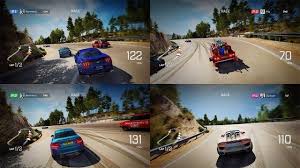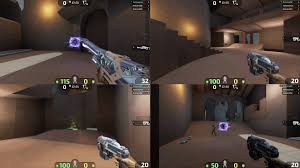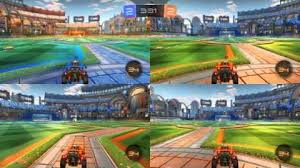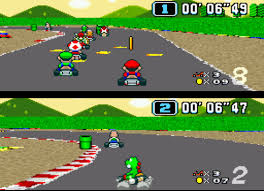In this piece, we’ll explore the significance of multiplayer in gaming and examine its various forms. We’ll also venture into more intricate topics, shedding light on the mechanics behind contemporary online multiplayer games. You’ll discover how today’s first-person shooters have effectively tackled lag issues and crafted engaging, real-time experiences for players around the globe—or at least created the illusion of such. If you’re curious about developing a multiplayer game or simply want to learn more about how multiplayer dynamics function, this article is tailored for you.

Let’s begin by addressing why multiplayer matters in today’s gaming landscape. This isn’t going to be a dramatic tale of multiplayer overshadowing single-player experiences. 57% of gamers still lean towards solo play. The remaining players either prefer multiplayer options or are indifferent. Interestingly, this preference for single-player games holds steady primarily among those aged 35 and older. In contrast, younger gamers—those under 35—are increasingly gravitating towards multiplayer formats.
The shift is significant: modern games are evolving into social arenas where cooperative gameplay fosters interaction, self-expression, and digital camaraderie with friends. This adds a fresh layer to the gaming experience that complements the traditional escapism offered by solo adventures—especially relevant in our post-pandemic world. Instead of overwhelming the industry, multiplayer games are establishing their niche by addressing unique player needs.
What is multiplayer, really? Before we dive deeper, it’s essential to define what multiplayer means. For the average gamer, who might not have a background in game development, multiplayer simply refers to two or more players engaging within the same virtual environment. However, for a programmer who understands the complexities of synchronising client data, multiplayer can be quite a puzzle. Picture the game as a sequence of turns; each turn comprises various commands that dictate the game’s progression—moving a character, launching an attack on an opponent, constructing buildings, and so forth. The critical challenge in a multiplayer scenario is ensuring that every player’s system executes precisely the same commands and turns from an identical starting point.
Now, let’s explore the different types of multiplayer experiences available.
Split Shared Screen Multiplayer: In this format, you and your friends gather around one device—perhaps a television or computer monitor—to play together. The screen is divided into sections for each player’s viewpoint. Typically, each player uses their controller or input device to navigate their character while the game software manages all actions on that single screen.
Local Multiplayer: This type allows multiple players to use different devices but remain in close proximity—think of separate computers or consoles set up in one room. These devices connect through local networks (like Wi-Fi) or directly using cables such as Ethernet or HDMI. The game software ensures that all players can interact seamlessly within the shared gaming world.

In essence, understanding these dynamics enriches our appreciation of what makes multiplayer gaming such an engaging experience.
Online Multiplayer Gaming: A Global Connection
In the realm of online gaming, players from across the globe can come together to engage in thrilling adventures over the internet. Each participant utilises their devices to connect to a central server, which the game’s developers may operate, an external service provider, or even another player. This server is responsible for overseeing the game environment and ensuring that all players’ actions are in sync. Continuous data exchange occurs between players and the server, relaying information such as player locations, actions taken, and chat communications to maintain a cohesive experience for everyone involved. Players have various means of communication at their disposal—be it through text messages or voice chat—and they often find themselves teaming up with individuals they’ve never met before. In this discussion, we will focus solely on local (LAN) multiplayer and online multiplayer experiences while highlighting the incredible skill of engineers who have mastered the art of synchronising diverse gaming experiences into one seamless adventure.

Peer-to-Peer Connections
In the early days of online multiplayer gaming, a network model known as peer-to-peer (P2P) was prevalent. This approach allowed players to connect directly with one another’s devices without relying on a centralised server for gameplay. In this setup, each player’s device functions both as a client and a server, enabling real-time interactions among participants. The P2P model remains relevant today, particularly within real-time strategy (RTS) games. Let’s explore how this system works:
Connecting Players: Within a P2P framework, gamers typically link their devices directly via a local network—such as during LAN gatherings—or sometimes over the Internet itself. They achieve this connection using IP addresses or by establishing virtual networks.
Game Mechanics: Every player runs their instance of the game software on their device; this software governs rules, physics dynamics, and player interactions. Unlike conventional client-server models, where all responsibilities fall on one central server, in P2P gaming, each device shares these duties collectively.

Data Synchronization: To maintain a unified game experience for all participants, players exchange data directly with one another. This information encompasses player locations, actions taken, and the overall state of the game. Continuous updates are sent and received by players to keep everything aligned.
Advantages:
Reduced Latency: Peer-to-peer (P2P) gaming can provide quicker response times than games that depend on centralised servers, as the data does not need to be routed through a central hub.
– Decentralization: The absence of a dedicated server lowers infrastructure expenses for developers.
– Ideal for Small Groups: P2P gaming is particularly effective for smaller gatherings, such as friends playing together locally or over a home network.
Challenges:
– Desynchronization: It can be challenging to achieve identical gameplay across all devices. Minor variations, like a character taking slightly different routes on different systems, can accumulate into significant inconsistencies over time.
– Slow Players: The game must wait for all players’ commands to be submitted before processing any turn. Consequently, everyone experiences delays based on the slowest player’s internet speed.
– Lobbies: Since synchronisation relies on sending only the command messages that alter the game state, all players need to begin from an identical starting point. Typically, this requires gathering in a lobby prior to gameplay. Although late joining is technically feasible, it is rare due to the challenges of establishing and transmitting a consistent starting point during an ongoing game.
– Cheating Risks: P2P gaming may be more vulnerable to cheating since players have greater control over their devices’ game mechanics.
Scalability Issues: P2P setups generally struggle with large-scale multiplayer environments due to the increased complexity of data synchronisation as more players join.
P2P gaming is typically associated with games that have fewer participants, such as cooperative or competitive titles played among friends, particularly in local or LAN environments. In contrast, massively multiplayer online games (MMOs) or those with a more extensive player base usually employ a client-server architecture due to their ability to scale and implement anti-cheating protocols. While P2P gaming is mainly linked to local multiplayer—where players connect directly in the same physical space—it is less common for online multiplayer scenarios where users are spread across various locations and rely on internet connectivity. In these cases, a central server is utilised to manage communication, synchronise the game state, and ensure a more stable and equitable gaming experience. This server can be established by the game developers, third-party providers, or even individual players.

In the client-server model, the dynamics of player interaction shift significantly. Rather than each participant running identical game code and communicating directly with one another, players function as clients that interact with a central server. The requirement for absolute consistency across all devices diminishes since the game’s core logic resides on the server itself. Each client merely serves as an interface that presents an approximation of the game based on information from the server.
Clients do not execute game code locally; instead, they transmit inputs—such as keystrokes and mouse actions—to the server. The server processes these inputs (typically at 30 updates per second for real-time games), modifies each player’s character state within the game world accordingly, and relays updates about the game’s current status back to all clients. Clients simply need to interpolate between these updates smoothly to create an illusion of continuous gameplay.
Consequently, the quality of gameplay now hinges on the connection between each client and the server rather than being affected by any single player’s lagging performance. This model also facilitates players joining or leaving games at will while enhancing scalability by reducing average bandwidth requirements per participant. Many real-time strategy (RTS) games operate under this framework (like Starcraft), albeit with some variations.
The Latency Issues With Client-Server Models
Despite the advantages of the client-server model, several obstacles remained. In the early iterations of online first-person shooter (FPS) games, players often experienced noticeable delays between their actions and the corresponding in-game responses. For instance, when a player pressed the forward key, there would be a lag as their command traveled to the game server and back before their character began to move. The same delay occurred when firing a weapon; players had to wait for the game to register their action. This issue stemmed from latency—the duration it takes for data to move between a player’s device, their Internet Service Provider (ISP), and the game server.

Factors Contributing To Latency Include:
-Geographical distance: The physical space separating a player’s device from the game server can influence latency levels. Generally, greater distances lead to increased latency since data packets require more time for round trips.
– Network congestion: Heavy internet traffic or bottlenecks within network infrastructure can delay data packet transmission as they queue for processing.
– Server load: The number of simultaneous requests on a game server can affect its response time. A server under heavy load might take longer to handle incoming data from players.
– Packet loss- Occasionally, data packets may be lost during transmission, resulting in delays while they are resent.
The impact of latency manifests in several ways:
-Input delay: Elevated latency can create a lag between when a player executes an action (like shooting) and when that action appears in-game, leading to an unresponsive gaming experience.
– Character jitter: Due to delayed server updates, players may observe characters or objects moving unpredictably on-screen.
– Unpredictable interactions: In fast-paced scenarios, high latency can result in erratic and unfair exchanges among players, complicating efforts to maintain competitive balance.

– Hit registration problems: In combat-focused games, latency can disrupt hit detection accuracy, causing shots that should connect to miss or vice versa.
Teleport Battle VR-iX
A few years back, we embarked on a project named Teleport Battle VR-iX, which utilised a client-server model for multiplayer interactions. Designed specifically for the HTC Vive and built on the Unity 3D engine, this game featured real-time multiplayer capabilities through the Photon network. The gameplay mechanics were refreshingly straightforward and immensely fun: players positioned themselves on towering pillars in the sky. One VR controller allowed players to teleport between these pillars, while the other functioned as a weapon to knock down their opponents’ pillars. The objective was to make your opponent fall while ensuring you remained standing. This client-server framework suited the game perfectly; character movements—like head and arm gestures in VR—were kept separate from overall gameplay and invisible to others. Consequently, only data related to teleportation and pillar destruction was sent to the server and other players, making any slight latency delay quite tolerable.

Speed Crew
However, when it comes to fast-paced action games or those requiring simultaneous interactions from multiple participants, the situation changes significantly. Even minor latency can greatly hinder gameplay quality, potentially making it unplayable. Our latest endeavour, Speed Crew—developed in collaboration with Wild Fields—emphasised speed and teamwork as its fundamental aspects. This lively party game focuses on collaborative efforts and effective time management while players tackle various pit-stop tasks amidst complex levels and environmental challenges. For such a dynamic project, we needed an advanced solution for online multiplayer that ensured rapid responsiveness and precise coordination among players.
This is where input prediction and lag compensation techniques come into play.
Predictions
Client-side prediction is a technique where the client can anticipate character actions until it receives definitive feedback from the server. This marked a departure from earlier models where clients simply relayed inputs to servers while interpolating between received states. Instead of being passive transmitters of information, clients now take an active role by predicting character movements locally and responding instantly to user inputs. Essentially, part of your character’s logic runs directly on your machine; thus when you press forward, there’s no delay waiting for data exchange between client and server—the character begins moving immediately.

In a similar vein, the client endeavours to anticipate the behaviours of other players by utilising information it has gathered locally from its most recent exchange with the server. For instance, if another player is heading in a particular direction, the client assumes they will maintain that trajectory until new data arrives from the server. This predictive approach allows for immediate reflection of player actions on their screen, thereby minimising any sensation of lag. Such predictions enhance the game’s responsiveness for players, even when latency is present. Nonetheless, this can occasionally result in visual mismatches between what players observe and what is actually occurring on the server.
To counteract these discrepancies, lag compensation techniques ensure equitable interactions among players when their actions need to be synchronised. Lag compensation is an essential tool in online multiplayer gaming, designed to lessen the impact of network latency on gameplay. Its purpose is to foster a fair and responsive environment for all players,  in scenarios where individuals with different latency levels engage within the same game.
in scenarios where individuals with different latency levels engage within the same game.
Here’s how it functions: In online gaming scenarios, participants connect to a game server via the internet, with data packets travelling back and forth between each player’s device (the client) and the server itself. Network latency introduces delays in this data transfer process. Consequently, there may be instances where what a player perceives on their screen needs to catch up to the actual state of play on the server.
When it comes to multiplayer interactions—like shooting at opponents or executing moves that influence the game world—players without lag compensation would find themselves at a disadvantage based solely on their connection speeds; those with lower latency would have quicker action registration by the server compared to others experiencing higher delays.
The mechanism behind lag compensation strives for balance by factoring in each player’s latency. When one player acts—such as firing their weapon—the game server logs that action’s timestamp. If another player becomes affected by this action (for example, getting shot), the server calculates how long it took for that data to travel from shooter to target. It then sends relevant information back to that target player’s client while effectively rewinding time within the game state back to when that initial action occurred—compensating for any delay experienced by the shooter. This simulation ensures that even those with higher latencies perceive interactions as fair and aligned with reality within their gaming environment.

While prediction focuses primarily on delivering smoother gameplay experiences for individual players by mitigating perceived latencies’ effects, lag compensation emphasises fairness and synchronisation among varying latencies during player interactions. Together, these techniques create a balanced and enjoyable atmosphere in online multiplayer games.
This explanation simplifies complex processes inherent in modern first-person shooters but illustrates how developers manage communication delays between servers and clients during intense multiplayer sessions effectively. The integration of both prediction and lag compensation played a crucial role in our ability to design an exhilarating high-speed multiplayer mode for our partner’s title, Speed Crew.
When embarking on the journey of crafting a multiplayer game, there are several crucial elements to keep in mind. First and foremost, it’s vital to embrace the multiplayer aspect from the very beginning. The initial architectural choices you make—such as whether to adopt a peer-to-peer or client-server model, which network protocols to utilise, and how to ensure scalability—will significantly influence both the game’s performance and the overall experience for players. Overlooking these decisions early in development can result in complicated and expensive revisions later on.
Moreover, it’s essential to recognise that multiplayer functionality is not just an add-on that can be tacked onto a game at its conclusion. It requires ongoing dedication throughout the entire development process. Regular testing, debugging sessions, and updates are critical for sustaining a stable and enjoyable multiplayer environment. Failing to commit to this continuous effort may lead to frustrated players and dwindling community engagement.

Additionally, developers should accurately estimate both time and budget when implementing multiplayer features. This endeavour often demands significantly more work—approximately 1.5 times that of creating a single-player experience—due to factors like networking code, synchronisation challenges, anti-cheat mechanisms, and server infrastructure requirements. Planning for this increased workload is essential; doing so will help pave the way for a successful launch of your multiplayer game. Cutting corners in this area could result in technical difficulties and unhappy players down the line.
How Maxthon Optimizes Multiplayer Games
- Enable Hardware Acceleration
Enable hardware acceleration in the Maxthon browser settings. This feature utilises your computer’s GPU, improving graphics performance and responsiveness during gameplay.

- Utilize Cloud Sync Features
Leverage Maxthon’s cloud sync capabilities to store game settings and preferences. This ensures that your gaming experience is consistent across different devices.
- Adjust Resource Allocation
Navigate to the advanced settings and allocate more resources to Maxthon when playing multiplayer games. By prioritising the browser’s usage of CPU and RAM, you can reduce lag and improve frame rates.
- Disable Unnecessary Extensions
Turn off any non-essential extensions or add-ons before launching a game. This frees up processing power and minimises potential interruptions from extraneous activities running in the background.
- Optimize Network Settings
Adjust proxy settings if necessary to optimise your network connection within Maxthon. Improved network speed reduces latency, leading to smoother online play.
- Clear Cache Regularly
Implement regular cache-clearing routines after gameplay sessions. A clean cache helps maintain optimal performance by preventing slowdowns caused by stored data buildup.
- Use Lite Mode for Gaming
Activate Maxthon’s Lite Mode, which compresses web content for faster loading times and reduces the amount of data processed while gaming.
- Monitor Performance Tools
Take advantage of Maxthon’s built-in performance monitoring tools to track memory usage and detect bottlenecks during gaming sessions.
- Keep Your Browser Updated
Ensure that you keep your version of Maxthon updated with the latest patches and features, deexplicitly designed to enhance performance in multiplayer environments.
By following these steps, you’ll be well on your way to optimizing your multiplayer gaming experience using Maxthon!
